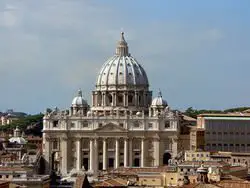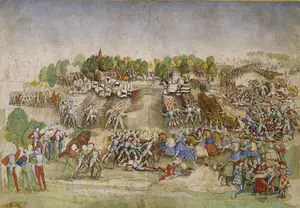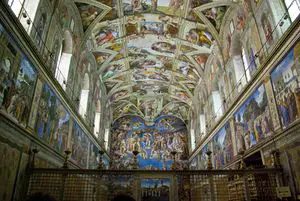What was the role of the Popes in the Renaissance
The Renaissance period was a time of renewed influence and power for the Papacy in Italy and also internationally. The era from 1420 to 1517 saw it reach new heights of power and become a great patron of the arts. This article will examine the role of the Papacy in Renaissance Italy and its contribution to the great flowering of art and culture at that remarkable time. The article will show that the Papacy became the absolute rulers of the Papal States, who played a leading role in Italian politics. The Papacy was largely secular and this allowed Italy’s artists and writers to work in an environment that was relatively free. Finally, the Papacy was one of the leading patrons of the arts at this time and they commissioned many of the greatest works in the western tradition. This piece will argue that the character of the Renaissance was shaped by the Pope’s in Rome. It will also demonstrate that the Papacy, with its corruption and secular preoccupations were a major factor in the Reformation.
The Impact of the Great Schism of 1378
The Papacy had experienced perhaps its greatest ever crisis in the 14th century. This was the ‘Great Schism of 1378’ which left the Church divided for some forty years. The roots of the schism lay in the intervention of the French monarchs into the affairs of the Papacy, that eventually led to successive Popes living in Avignon, in Southern France.[1] By 1378 the church was divided between Cardinals who were pro-French and who wanted to stay in Avignon and Italian Cardinals who wanted to return to Rome. By 1378 the Church had two Popes one based in Avignon and one based in Rome. The situation became even more confused when a third Pope was elected. This continued for almost forty years until the Council of Constance, when cardinals from all over Europe elected Pope Martin V (1417-1431) as the sole Pope in Rome.
Martin effectively ended the ‘Great Schism’, was the first of the Renaissance Popes and he reestablished the Papacy in Rome.[2] The successors of Martin were able to make the Eternal City once more the center of Christendom. The city at this time despite not being a commercial center saw a period of massive economic growth driven by the spending of pilgrims and contributions from churches throughout Europe. The city soon became wealthy and the Pope’s treasury overflowed. The power and the prestige of the Papacy grew during the reigns of the 14 Popes of the Renaissance era. However, this golden era for the Popes ended in 1527, when the mutinous army of the German Emperor Charles V besieged and sacked Rome, killing thousands and leaving much of the city in ruins. The ‘Sack of Rome’ in 1527 is seen as not only the end of the Renaissance Papacy but also the Renaissance.[3].
What was the Popes influence on Renaissance Culture?
Rome had fallen into a state of disrepair and near ruin after the Papacy had relocated to Avignon. The Renaissance Popes were determined to restore Rome and to make her once again the capital of a united Christendom. The Church employed many humanists to work in the Curia, the Papal bureaucracy. These humanists also studied the many classical texts that were held in Papal archives and libraries.[4]. They did much to make the ancient world better known in this period and inspired many to emulate the classical era. The Papacy began to spend its wealth on ways to beautify the city. All the Popes in this period were great patrons of the art and were often real connoisseurs. They were very keen to collect antiquities from the ancient past and indeed helped to rediscover great works of art. Julius II and his agents unearthed such great works of art from the Roman past, such as the Apollo Belvedere.[5]
During this period successive Popes rebuilt the city and using Imperial Rome as a model, had great basilicas and plazas built. Pope Sixtus VI was a great builder, he widened the streets and commissioned the Sistine Chapel. The city was transformed during the Renaissance Papacy. The rebuilding of the city at this time was a political statement, it was to show the world the might of the Popes and demonstrate their unique status as leaders of the Church. Popes commissioned great artists to create masterpieces for the Vatican.[6] They also allowed the artists great freedom of expression and their money allowed painters, sculptors and architects to devote themselves to their art. They attracted the greatest talents from all over Italy to the ‘Eternal City’. Pope Julius II paid Michelangelo to paint the Sistine Chapel’s ceiling. Leo X is well known for his patronage of Raphael, whose paintings still adorn the Vatican. The Papacy was to commission many more masterpieces at this time and without their generosity, the artistic achievements of the period would have been far less.[7]
What role did the Popes play in the Politics of Italy?
The Pope after the return to Rome were eager to reestablish their role in the politics of Italy. The Papacy was in many ways just another territorial ruler and they saw no contradiction between this and their spiritual role. The Popes owned extensive lands in Central and Southern Italy and also in Southern France. The Papacy had lost much of its authority in their own lands surrounding Rome and successive Pontiffs sought to reclaim these territories, which, were known as the Papal States. Their priority was to reclaim their rights in the Papal States, during the ‘Babylonian Captivity’ of the Pope in Avignon local rulers had seized much of central Italy.[8]. It was not until the start of the 16th century that the Popes had full control of the Papal States. The Popes reformed the States and they began to resemble the nation-states of Europe with a centralized bureaucracy and standing army. To secure their position the Popes made themselves the absolute ruler of these lands, they curbed the powers of the feudal lords and reduced their powers.
The growing power of the Papacy in central Italy made the Pontiff, perhaps the most important ruler in Italy[9]. The Pontiff began to resemble the absolute monarchies of England and France. The Pope although the head of the Catholic Church acted like any other secular leader of the time. The Pope’s with their great wealth they were able to raise armies of mercenaries and they fought wars to reclaim their lost lands in central Italy. They also played an important role in the politics of the Italian City-States and they often entered into alliances with Republics and fought wars to secure their interests. The Popes were also very active in international affairs and were often eager to build alliances against the growing power of the Ottoman Turks.[10]

Papal Corruption
The Pope was the head of the Catholic Church and the spiritual leader of millions of Christians in Europe. However, the great wealth and power of the Papacy corrupted the various holders of the office and this was to have a marked effect on Renaissance Italy.[11] Many Popes were more interested in advancing the interests of their families and they often lavished money and lands on their family members. The Popes often showed great favors towards their nephews. Many nephews of Popes became very powerful in Rome in the Church and politics. For example, Pope Calixtus advanced his nephew to high office in the Curia and he eventually became Pope Alexander VI. The Papal favoritism of nephews led to the coinage of the term of ‘nepotism’. The Pontiff was usually a worldly figure at this time. Pope Leo X spend lavishly and lived the high life and Julius II was known as the ‘‘Warrior-Pope’ for his love of war.’’[12] This and their lavish patronage of the arts resulted in serious financial difficulties for the Church despite its vast wealth, by the end of the fifteenth century. Many of the Popes led scandalous lives, such as Alexander VI, who had many mistresses and several children [13]
Papal corruption was nothing new and in the Dark Ages the Papacy had been possibly even more corrupt. The Renaissance Papacy, despite the holiness of some, such as Sixtus IV, was largely secular in its outlook. The uniquely secular culture of at least the elites in Italy was encouraged by the secularism of the Papacy. This meant that the many artists and writers at the time had no fear of offending the Pope and the Church and had therefore almost unlimited freedom of expression. This was despite the fact that many of them celebrated ancient and non-Christian values. This also allowed great writers such as Machiavelli or artists such as Leonardo to express their interest in the classical and natural world without fear of being accused of irreligion[14]. In previous eras, the Inquisition would have investigated their writings and beliefs of such writers and thinkers. During the Renaissance, the Inquisition was almost dormant, thanks to the lack of interest of the Popes in the enforcement of religious orthodoxy.[15] When the Papacy become more religious and spiritual during the period after the Sack of Rome, the culture of Italy was less favorable to freedom of thought and expression and this led to a decline in the arts.
Papacy and Religion
Perhaps the great impact of the Papacy on Italy and beyond was on religious belief. The increasing secular outlook and policies of the Pope came to be viewed with disgust and outrage by many religious people, especially outside Italy. Many people in Christendom were worried that if the Pope was corrupt, was the church also corrupt and what did this mean for their salvation.[16] The Church at this period was in need of reform, all over Europe. The Popes did not attempt to reform the clergy and were too preoccupied in the pursuit of their interests in Italy and especially in the Papal States. The lives of the Popes scandalized many and led to many becoming disenchanted with the Catholic Church.
Martin Luther visited Rome and was appalled by what he saw in Rome and at the Papal Court. The corruption of the Popes, such as Alexander IV, led to many people losing respect for the Papacy and even the Church. People grew tired of the endless demands for money by the Popes and they especially resented the sale of indulgences. These indulgences were sold by the Pope to shorten a souls stay in Purgatory after their death and many people, including the clergy saw it as a fraudulent practice.[17]
Leo X sold indulgences in order to raise funds for the rebuilding of St Peter’s Basilica and this did much to harm the reputation of the Pontiff in German-speaking lands. The Renaissance Papacy inadvertently did much to spur the reform movement, that began when Martin Luther nailed the 95 theses to a Church Door in Wittenberg Germany and which ultimately led to a permanent schism in Christianity. The Renaissance Papacy with its worldliness greatly contributed to the Reformation and ended the unity of Christendom in Western Europe.[18]
Conclusion
The Renaissance was in many ways a golden age for the Popes, they returned to Rome after almost a hundred years and became once more independent of the French monarchs.[19] They Papacy recovered most of their lands in Central Italy and would remain a power in Italy until 1871. They also beautified Rome and did much to encourage the arts and literature by their patronage of great figures such as Michelangelo. The Papacy was also tolerant and this was essential in the great cultural flowering in Italy at his time.
However, this all came at a great cost. The Popes became wealthy, powerful but corrupt and secular and neglected their spiritual role. They often advanced the interests of their families and personal ambitions no matter what the costs. The prestige of the Church declined and this lead to increasing disillusionment with the Church and ultimately it was to lead to the rise of Protestantism and the division of Christendom into two hostile religious groups, Catholics, and Protestants.
References
- Jump up ↑ Duffy, Eamon. Saints & Sinners: A History of the Popes. (Yale University Press, 1997), p. 211
- Jump up ↑ Duffy, p. 314
- Jump up ↑ Tuchman, Barbara W., The March of Folly: From Troy to Vietnam. Random House Trade Paperbacks, 1985), p. 167
- Jump up ↑ Tuchmann, p. 118
- Jump up ↑ Duffy, p. 319
- Jump up ↑ Ruggiero, Guido. The Renaissance in Italy: A Social and Cultural History of the Rinascimento (Cambridge University Press, 2015). 648 pp
- Jump up ↑ Ruggerio, p. 645
- Jump up ↑ Duffy, p. 313
- Jump up ↑ Duffy, p. 317
- Jump up ↑ Johnson, Paul. The Renaissance: A Short History (Longman, London, 2000), p. 197
- Jump up ↑ Johnson, p. 114
- Jump up ↑ Johnson. 119
- Jump up ↑ Duffy, p 321
- Jump up ↑ Johnson, p. 121
- Jump up ↑ Ruggiero, Guido, ed. A Companion to the Worlds of the Renaissance. ( Longman, London, 2002), p. 561
- Jump up ↑ Duffy, p. 334
- Jump up ↑ Bradshaw, Brendan (1983). "The Reformation and the Counter-Reformation," History Today. 33 (11): 42–45
- Jump up ↑ Bradshaw, p. 43
- Jump up ↑ Duffy, p. 302
Related DailyHistory.org Articles
- What was Pope Julius IIs contribution to Renaissance Italy?
- How did the Bubonic Plague make the Italian Renaissance possible?
- Did the Sack of Rome in 1527 end the Renaissance in Italy?
- What were the causes of the Northern Renaissance?
- How did the Renaissance influence the Reformation?
- What was the Borgias contribution to Renaissance Italy?
Admin, Ewhelan and EricLambrecht


